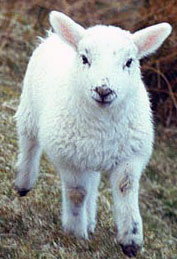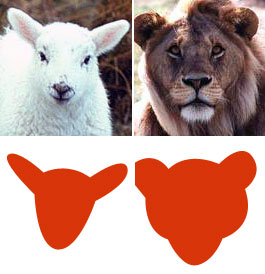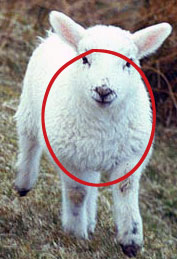That gave me chills.
Back then, I was newly emerged from long, dark years of knitting the same scarf and mittens over and over in solitude, using whatever yarn I happened to find. My proudest technical achievement was figuring out on my own how to work the thumb gore in the mitten pattern. It was incomprehensible to me that person could use yarn and needles as a sketchbook. I'd been "making up" stuff for years on paper; but what sort of freaky genius would you need to be to doodle with wool?
As it turns out, you don't really need to be genius, and I'm proof. When I put up the pictures of Abigail's Sheep in the Meadow sweater, this question came to mind because several of you were kind enough to ask how I'd made the sheep for the pocket. I realized I had no handy answer, because I improvised as I went along. I'd doodled with wool, or in this case a wool/cotton blend. Fancy that.
I've decided it boils down to having these things at your command:
- enough curiosity to want to deviate from written patterns, or make up your own;
- a willingness to pause and examine what's in front of you;
- a willingness to try different approaches until you create what pleases you;
- a working knowledge of basic moves in knitting, including increases, decreases, and the basic effects on the fabric created by knit, purl, and y/o;
- patience; and
- the understanding that it's just knitting, it's done one stitch at a time at your own pace, and you can undo it if you don't like it.
Mind you, this may prove incredibly boring. But as you asked for it, you have only yourself to blame.
The task before us is:
Knit a lamb to be attached, as appliqué, to the pocket of a baby sweater.
Step One: Take a Good Look at Your Subject
I'm a firm believer in a dictum often expressed by Charles M. Schulz, creator of Peanuts and a personal household god: if you can't draw it realistically, you can't cartoon it convincingly.
Not that you must be able to sketch a photorealistic lamb in order to knit one. No.
But if you're trying to simplify an object in order to render it in stitches, you should have the level of familiarity that comes of from closely examining the original. You can't show everything, so you'll have to determine what the absolutely essential details are. What makes a lamb look like a lamb?
So, in case you don't have a flock in the backyard, here's a photograph of a lamb. (You may pause to say, "Awwwwwwwwww.")

Wait–who said, "Pass the mint sauce?"
That's not my own sheep; I found it online. When you need reference material in a hurry, Google's image search function is your friend. Just be forewarned: seemingly innocent queries like "sheep" or "cupcake" can yield shocking results. Turn on the "safe search" filter if you have a low tolerance for surprises.
Usually, when I'm drawing an object I haven't worked with a whole lot, I don't just look at one picture. If possible, I seek out the real thing and make sketches or photographs on the spot. If that's impossible, I look over photographs of as many as I can in order to synthesize in my head what the essential characteristics are.
In the case of the lamb, you might decide after some concentrated looking that these characteristics communicate "lamb" visually:

Or you might find yourself focused on other aspects. There are no correct answers. This is your lamb, seen through your eyes. You will find your own path to lambishness.
Step Two: Establish a Simple Silhouette
Usually it's the shape or outline of the object, also called the silhouette, that most efficiently communicates at a glance what one is looking at. I find this to be especially true of animals.
Smaller details, like noses, are often suprisingly similar even across species. Here are two noses from that perennially opposed pair, the lion and the lamb.

Simplify them, as in a cartoon, and the similarity is even greater.

Silhouettes are another story. Pull back to reveal the full outline of the head, and you're never going to mistake these two for cousins, even with all other details removed.

Since in this case we're knitting a small, flat item at a relatively large gauge (about five stitches to the inch), our silhouette is extremely important–there won't be much room for smaller details. Furthermore, the silhouette must be reduced to its absolute basics–the simplest and fewest geometric forms.
So, as the final step for today's entry, here's how you might see the major outlines of the sheep you intend to knit.
You need a head.

And you need a body.

Together, they look like this.

Next time, we pick up the needles.
I hope you can bear the suspense.
Oh my, so very technical. Um, I mean, awwwwwww.
ReplyDeleteGarlic, lots of garlic...
ReplyDeleteI mean, awwwww...how very cute.
Not boring at all. Very interesting.
ReplyDeleteI had never seen a picture through cartoonist eyes. I have to admit I am stunned.
ReplyDeleteAnd yes, awwwww
Manon
You are so cool to explain this. So very, very cool.
ReplyDeleteYou *are* some kind of freaky genius :-) I had a heck of a time trying to knit a sailboat a while back. I definitely did not start with a picture of a boat. Might be time to try again... thanks!
ReplyDeleteI'm on the edge of my seat.
ReplyDeletedelurking to say how interesting it is to see this process broken down into steps. I have most of the attributes you list, but am rather lacking in an important one: patience. Nevertheless, it's fascinating to see how a patient person builds a knit ship. Looking forward to the next instalment.
ReplyDeleteand of course I meant "knit sheep" -- I think a glance at telmah's comment must have misdirected my typing fingers -- sheep -- sailboat -- ship, you know?
ReplyDeleteoh how clever, i love the part with the lion/lamb comparisons, keep it coming!
ReplyDeleteDelurking to say: SO interesting. When I set out to illustrate something, I hyperfocus on the details, and only gradually does the relationship of the details merge into a coherent whole. The exact opposite of cartooning, I guess.
ReplyDeleteShouldn't item #7 on the list be "Alcoholic beverage of appropriate strength and quantity for task at hand"?
ReplyDeleteMe. I said, "mint sauce." And curry, too.
ReplyDeleteShit.
I mean, "awwwwwwww."
I learned about Google surprises when I was waiting to adopt my daughter from Viet Nam. I thought I'd get ahead of the game and stock up on toys. I Googled "Asian doll"...
ReplyDeleteMarie in Michigan
Franklin...I have been a lurker for quite some time, but I had to come out of hiding today to thank you so much for this instruction. I create recipes in this exact manner, but had never applied this technique to knitting...what a revelation! You're right up there with EZ on my knitting pedestal for opening my creative eyes from this moment on.
ReplyDeleteam loving the image to drawing technique you are showing. My professional artist daughter is able to see what you see, but I never know quite how she does it :-)
ReplyDeleteso, thanks!
I look forward to the next installment!
this is one great tutorial. make a book and teach everyone to draw. you make it sooo simple. and your maltese hat is lovely. great pattern.
ReplyDeletequote: "But if you're trying to simplify an object in order to render it in stitches, you should have the level of familiarity that comes of from closely examining the original"
ReplyDelete!!! That may be my problem with knitting dragons!!! though I'm fairly certain that they exsist somewhere - just read HP if you don't believe me - I just haven't been able to find them around for the purpose of my studying them ;-)
Other than that, I'm looking forward to the continuation. Very interesting.
that was really cool...thanks.
ReplyDeleteAwwwww, but definitely garlic and marination in a good red wine. No mint sauce.
ReplyDelete"Fluffy and white"? You're discriminating against all lambs of color? Tsk, tsk.
As one who has great difficulty rendering a recognizable image of practically anything, I found this very helpful and far from boring, especially, seasoned as it is, with dashes of humor.
ReplyDeleteI'm looking forward to the next installment.
And yes, the hat is stupendous. I can wear very few hat styles and so am consumed with envy.
Thanks!
Thank you for this lovely tutorial. It is so very nice of you to share how you "see" things.
ReplyDeleteI now expect that in the near future on blogs everywhere (and on Ravelry) there will be a proliferation of finished sweaters, hats, scarves and mittens with sheep on them!
Franklin - that's wonderful! I love the way you make it all seem so simple and easy. Yet another great talent from the talented Mr. Franklin
ReplyDeleteps. ever thought about teaching?
This is a great post... perfect for those of us who are new(ish) and completely intimidating by this stuff. ;)
ReplyDeleteintimidated... that's what I meant (hate those typos!)
ReplyDeleteDang knittus interruptus--um sorry.
ReplyDeleteOoooooo what a cuuuute lambie!
(Thanks for the tutorial!)
Hi Franklin-
ReplyDeleteDelurking for a moment. It's so satisfying to check in and read your well-written, funny words on the sort of process I go through with drawing as well as knitting. :) It's so affirming somehow to encounter another person who does this sort of thing. :) And you articulate it so well. Thank you.
That "skeletonized" drawing of the lion's mouth is INSTANTLY recognizable as a lion! I've seen many children's book illustrations of lions that must have started with that as the crucial feature. Manes, etc, are only secondary. GREAT lesson in drawing, Franklin. Thanks!
ReplyDeleteArt class 101. Thank you for taking us back to see basics and simple design.
ReplyDeleteBut but but... FrAAANklin.. if you teach the knitters how to think about what they are doing whatever will we pattern designers do???
ReplyDeletehehe.. keep it up this is good stuff!It;s oh so easy if you just step back and take that deep breath and jump in realizing it's just yarn and you can pull it out and try again!
Thanks for the tutorial and just in the nick of time as one of my goals for this year is to improve the quality of my sketching.
ReplyDeleteFranklin, if you would become a teacher I believe you boost the flaccid writing scores of our fine state. But I'd place even odds on whehter you'd kill the students, the parents or the administration first.
ReplyDeleteWas that Dolores' baby picture?
michelene
You're AWESOME!
ReplyDeleteThanks!!
"You will find your own path to lambishness." Oh, stop, oh my side aches, I'm crying! You are my prophet!
ReplyDeleteSeriously though, what a wonderful tutorial! (And I'm a vegetarian--'twas not I who yelled mint sauce!)
I know it's an instructional post, but I just am loving the cuteness of that lamb, over and over again. it cracks me up! plus yeah the learning part. although my brain is rather full right now so i'll focus on the fluffy cute bits for now.
ReplyDeleteYep, very very interesting. And as I must follow the flock...awwwwwwwwww! (But that is a particularly cute lamb.)
ReplyDelete1. I'm with Knititch - tutorial on cartooning (a book, not online). This is FASCINATING! I can't draw soda through a straw, so it's intriguing to see this process (makes me think, if briefly, maybe I COULD draw...) That's it, I'm coming to Chicago and I WILL have tea with you, Jewish Bubbehs are NOT to be denied. Details at 11:00. (...and it might've been me too, yelling "Mint sauce"...)
ReplyDeleteoh-oh...that "coming to Chicago" bit? That was supposed to be #2. Nevermind.
ReplyDeleteNo, no, not "mint sauce". That was "tzatziki".
ReplyDeleteokay aawwwwwwwwwwwwwww
ReplyDeleteI just love the way that you can so clearly put into words a working method that I always seem to have understood and implemented but have trouble getting across to other people.
Nice blog!!! i love to cook specially when my parents come to my home. In fact i am trying to get many recipes because i want to cook varieties. i think this blog is perfect because show many new ideas and is sure i will prove it.
ReplyDeletebuy viagra
Kondiloma akuminatum ialah vegetasi oleh Human Papiloma Virus tipe tertentu, bertangkai, dan permukaannya berjonjot. Tipe HPV tertentu mempunyai potensi onkogenik yang tinggi, yaitu tipe 16 dan 18. tipe ini merupakan jenis virus yang paling sering dijumpai pada kanker serviks. Sedangkan tipe 6 dan 11 lebih sering dijumpai pada kondiloma akuminatum dan neoplasia intraepitelial serviks derajat ringan. Kondiloma akuminatum ialah vegetasi oleh Human Papiloma Virus tipe tertentu, bertangkai, dan permukaannya berjonjot. Tipe HPV tertentu mempunyai potensi onkogenik yang tinggi, yaitu tipe 16 dan 18. tipe ini merupakan jenis virus yang paling sering dijumpai pada kanker serviks. Sedangkan tipe 6 dan 11 lebih sering dijumpai pada kondiloma akuminatum dan neoplasia intraepitelial serviks derajat ringan.
ReplyDelete